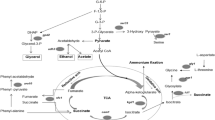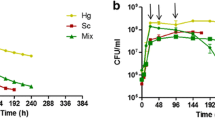Abstract
The yeast Saccharomyces cerevisiae is the main microorganism responsible for wine fermentation and its development influences the quality of wine. A problem affecting these types of fermentations, generating important losses in this industry, are the slow or stuck fermentations which may result from low nitrogen availability in the must. Therefore, several studies have been directed towards identifying genes involved in nitrogen metabolism using high throughput strategies which include subjecting the yeast to changes in the type or concentration of the available nitrogen source. However, this type of approach can also generate responses in the yeast that do not necessarily alter the expression of genes related to nitrogen metabolism. In this work, by using intraspecific hybridisation of wild wine yeast strains we obtained genetically and oenologically similar strains with differences in the consumption of nitrogen sources. Using the same must, the global expression patterns of these yeasts were compared by microarrays, the analysis of which identified 276 genes that varied in their expression between the strains analysed. The functional analysis of the genes with a known function indicates that some participate in nitrogen metabolism, alcoholic fermentation, ion transport and transcriptional regulation. Furthermore, differences were observed in the expression of genes which have been partially associated to nitrogen, as in the case of ZRT1 and ATO2. Interestingly, many of the genes identified have no known function or have not been previously associated to this phenotype.

Similar content being viewed by others
References
Bakalinsky AT, Snow R (1990) The chromosomal constitution of wine strains of Saccharomyces cerevisiae. Yeast 6:367–382
Bely M, Sablayrolles JM, Barre P (1990) Automatic detection of assimilable nitrogen deficiencies during alcoholic fermentation in enological conditions. J Ferment Bioeng 70:246–252
Blaiseau PL, Isnard AD, Surdin-Kerjan Y, Thomas D (1997) Met31p and Met32p, two related zinc finger proteins, are involved in transcriptional regulation of yeast sulfur amino acid metabolism. Mol Cell Biol 17:3640–3648
Blinder D, Coschigano PW, Magasanik B (1996) Interaction of the GATA factor Gln3p with the nitrogen regulator Ure2p in Saccharomyces cerevisiae. J Bacteriol 178:4734–4736
Bobrowicz P, Wysocki R, Owsianik G, Goffeau A, Ułaszewski S (1997) Isolation of three contiguous genes, ACR1, ACR2 and ACR3, involved in resistance to arsenic compounds in the yeast Saccharomyces cerevisiae. Yeast 13:819–828
Boulton RB, Singleton VL, Bisson LF, Kunkee RE (1996) Principles and practices of winemaking. Chapman and Hall, New York
Chen YJ, Stevens TH (1996) The VPS8 gene is required for localization and trafficking of the CPY sorting receptor in Saccharomyces cerevisiae. Eur J Cell Biol 70:289–297
Cox KH, Pinchak AB, Cooper TG (1999) Genome-wide transcriptional analysis in Saccharomyces cerevisiae by mini-array membrane hybridization. Yeast 15:703–713
Duncan D, Prodduturi N, Zhang B (2010) WebGestalt2: an updated and expanded version of the Web-based Gene Set Analysis Toolkit. BMC Bioinform 11(suppl 4):10
Dunn CD, Jensen RE (2003) Suppression of a defect in mitochondrial protein import identifies cytosolic proteins required for viability of yeast cells lacking mitochondrial DNA. Genetics 165:35–45
Dunn B, Levine RP, Sherlock G (2005) Microarray karyotyping of commercial wine yeast strains reveals shared, as well as unique, genomic signatures. BMC Genomics 6:53
Fernández-Espinar MT, Lopez V, Ramon D, Bartra E, Querol A (2001) Study of the authenticity of commercial wine yeast strains by molecular techniques. Int J Food Microbiol 70:1–10
Fernández-Espinar MT, Barrio E, Querol A (2003) Analysis of the genetic variability in the species of the Saccharomyces sensu stricto complex. Yeast 20:213–226
Gitan RS, Luo H, Rodgers J, Broderius M, Eide D (1998) Zinc-induced inactivation of the yeast ZRT1 zinc transporter occurs through endocytosis and vacuolar degradation. J Biol Chem 273:28617–28624
Hinnebusch AG, Natarajan K (2002) Gcn4p, a master regulator of gene expression, is controlled at multiple levels by diverse signals of starvation and stress. Eukaryot Cell 1:22–32
Horazdovsky BF, Cowles CR, Mustol P, Holmes M, Emr SD (1996) A novel RING finger protein, Vps8p, functionally interacts with the small GTPase, Vps21p, to facilitate soluble vacuolar protein localization. J Biol Chem 271:33607–33615
Janssen P, van Nispen J, Melgers P, van den Bogaart H, Hamelinck R, Goverde B (1986) HPLC analysis of phenylthiocarbamyl (PTC) amino acids. I. Evaluation and optimization of the procedure. Chromatographia 22:345–350
Jimenez-Marti E, del Olmo ML (2008) Addition of ammonia or amino acids to a nitrogen-depleted medium affects gene expression patterns in yeast cells during alcoholic fermentation. FEMS Yeast Res 8:245–256
Jiranek V, Langridge P, Henschke PA (1995) Amino acid and ammonium utilization by Saccharomyces cerevisiae wine yeasts from a chemically defined medium. Am J Enol Vitic 46:75–83
Kinclová O, Ramos J, Potier S, Sychrová H (2001) Functional study of the Saccharomyces cerevisiae Nha1p C-terminus. Mol Microbiol 40:656–668
Kleinschmidt M, Grundmann O, Blüthgen N, Mösch H-U, Braus G (2005) Transcriptional profiling of Saccharomyces cerevisiae cells under adhesion-inducing conditions. Mol Genet Genomics 273:382–393
Legras JL, Karst F (2003) Optimisation of interdelta analysis for Saccharomyces cerevisiae strain characterisation. FEMS Microbiol Lett 221:249–255
Liti G, Carter DM, Moses AM, Warringer J, Parts L, James SA, Davey RP, Roberts IN, Burt A, Koufopanou V, Tsai IJ, Bergman CM, Bensasson D, O’Kelly MJ, van Oudenaarden A, Barton DB, Bailes E, Nguyen AN, Jones M, Quail MA, Goodhead I, Sims S, Smith F, Blomberg A, Durbin R, Louis EJ (2009) Population genomics of domestic and wild yeasts. Nature 458:337–341
Livak KJ, Schmittgen TD (2001) Analysis of relative gene expression data using real-time quantitative PCR and the 2(-Delta Delta C(T)) Method. Methods 25:402–408
Marks VD, van der Merwe GK, van Vuuren HJ (2003) Transcriptional profiling of wine yeast in fermenting grape juice: regulatory effect of diammonium phosphate. FEMS Yeast Res 3:269–287
Marullo P, Bely M, Masneuf-Pomarede I, Aigle M, Dubourdieu D (2004) Inheritable nature of enological quantitative traits is demonstrated by meiotic segregation of industrial wine yeast strains. FEMS Yeast Res 4:711–719
Mendes-Ferreira A, del Olmo M, Garcia-Martinez J, Jimenez-Marti E, Mendes-Faia A, Perez-Ortin JE, Leao C (2007) Transcriptional response of Saccharomyces cerevisiae to different nitrogen concentrations during alcoholic fermentation. Appl Environ Microbiol 73:3049–3060
Palkova Z, Devaux F, Icicova M, Minarikova L, Le Crom S, Jacq C (2002) Ammonia pulses and metabolic oscillations guide yeast colony development. Mol Biol Cell 13:3901–3914
Pizarro FJ, Jewett MC, Nielsen J, Agosin E (2008) Growth temperature exerts differential physiological and transcriptional responses in laboratory and wine strains of Saccharomyces cerevisiae. Appl Environ Microbiol 74:6358–6368
Pretorius IS (2000) Tailoring wine yeast for the new millennium: novel approaches to the ancient art of winemaking. Yeast 16:675–729
Proft M, Struhl K (2004) MAP kinase-mediated stress relief that precedes and regulates the timing of transcriptional induction. Cell 118:351–361
Ribereau-Gayon P, Dubourdieu D, Doneche B, Lonvaud A (2000) Handbook of enology. Wiley, New York
Rossignol T, Dulau L, Julien A, Blondin B (2003) Genome-wide monitoring of wine yeast gene expression during alcoholic fermentation. Yeast 20:1369–1385
Salinas F, Mandaković D, Urzua U, Massera A, Miras S, Combina M, Ganga MA, Martínez C (2010) Genomic and phenotypic comparison between similar wine yeast strains of Saccharomyces cerevisiae from different geographic origins. J Appl Microbiol 108:1850–1858
Simón E, Clotet J, Calero F, Ramos J, Ariño J (2001) A screening for high copy suppressors of the sit4 hal3 synthetically lethal phenotype reveals a role for the yeast Nha1 antiporter in cell cycle regulation. J Biol Chem 276:29740–29747
Somogyi M (1952) Notes on sugar determination. J Biol Chem 195:19–23
Suzuki C, Hori Y, Kashiwagi Y (2003) Screening and characterization of transposon-insertion mutants in a pseudohyphal strain of Saccharomyces cerevisiae. Yeast 20:407–415
Sychrova H, Ramirez J, Pena A (1999) Involvement of Nha1 antiporter in regulation of intracellular pH in Saccharomyces cerevisiae. FEMS Microbiol Lett 171:167–172
Tamura S, Yoshimura E (2008) Promotion of Zn(2+) uptake by Al(3+) in a Saccharomyces cerevisiae mutant that lacks the ZRT1 gene encoding a high-affinity Zn transporter. Biol Trace Elem Res 124:262–268
Vaquerizas JM, Dopazo J, Rn Diaz-Uriarte (2004) DNMAD: web-based diagnosis and normalization for microarray data. Bioinformatics 20:3656–3658
Varela C, Pizarro F, Agosin E (2004) Biomass content governs fermentation rate in nitrogen-deficient wine musts. Appl Environ Microbiol 70:3392–3400
Winge O, Laustsen O (1938) Artificial species hybridization in yeast. C R Trav Lab Carlsberg Ser Physiol 22:235–244
Wu TK, Chang CH, Liu YT, Wang TT (2008) Saccharomyces cerevisiae oxidosqualene-lanosterol cyclase: a chemistry-biology interdisciplinary study of the protein’s structure-function-reaction mechanism relationships. Chem Rec 8:302–325
Zhang B, Kirov S, Snoddy J (2005) WebGestalt: an integrated system for exploring gene sets in various biological contexts. Nucleic Acids Res 33:W741–W748
Zhao H, Eide D (1996) The yeast ZRT1 gene encodes the zinc transporter protein of a high-affinity uptake system induced by zinc limitation. Proc Natl Acad Sci U S A 93:2454–2458
Zuzuarregui A, Monteoliva L, Gil C, del Olmo M (2006) Transcriptomic and proteomic approach for understanding the molecular basis of adaptation of Saccharomyces cerevisiae to wine fermentation. Appl Environ Microbiol 72:836–847
Acknowledgments
This research was supported by grants 1100509 (Fondecyt) and AT 24091033 (Conicyt). V. Garcia was supported by a DICYT-USACH Postdoctoral Fellowship.
Author information
Authors and Affiliations
Corresponding author
Electronic supplementary material
Below is the link to the electronic supplementary material.
Rights and permissions
About this article
Cite this article
Contreras, A., García, V., Salinas, F. et al. Identification of genes related to nitrogen uptake in wine strains of Saccharomyces cerevisiae . World J Microbiol Biotechnol 28, 1107–1113 (2012). https://doi.org/10.1007/s11274-011-0911-3
Received:
Accepted:
Published:
Issue Date:
DOI: https://doi.org/10.1007/s11274-011-0911-3




